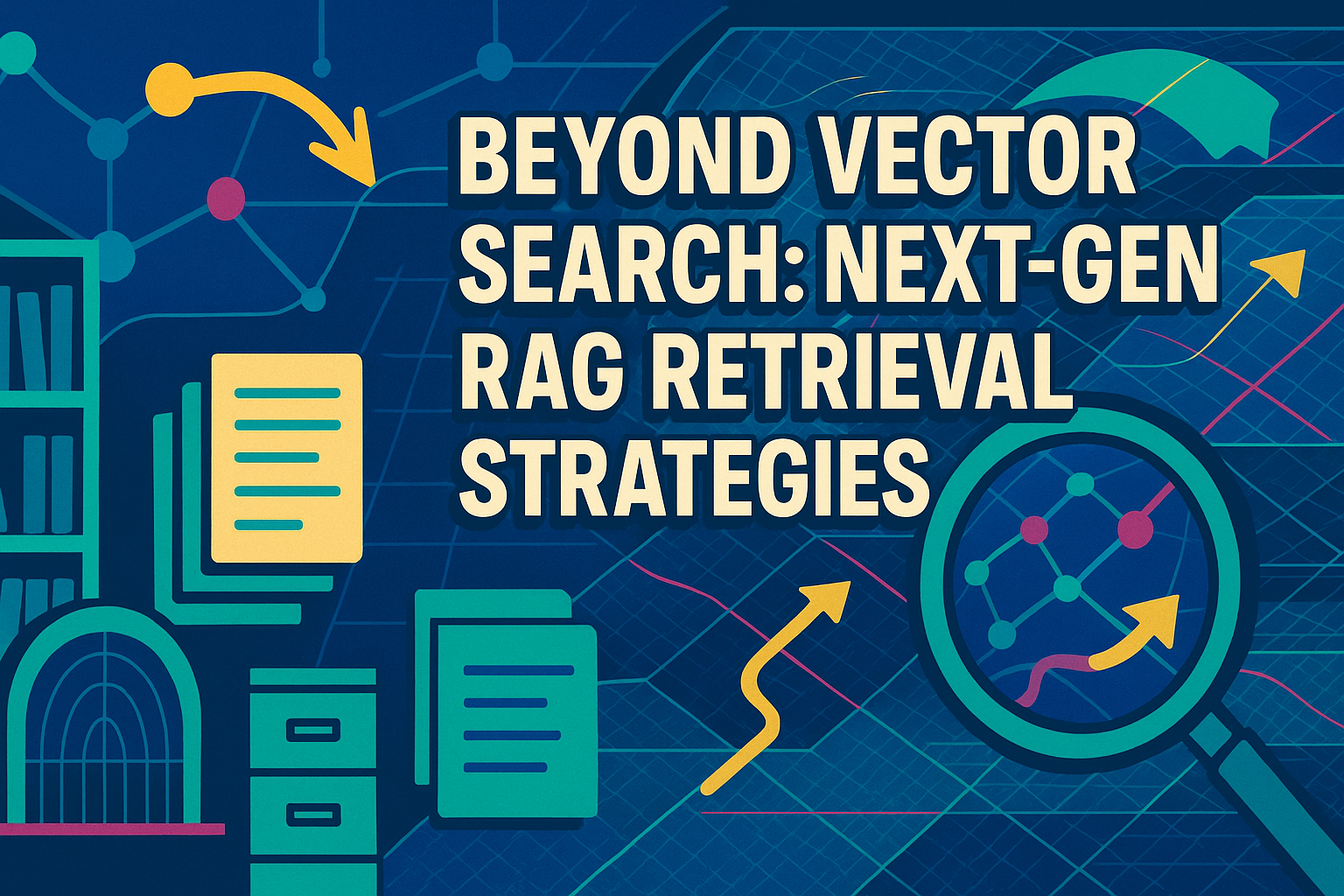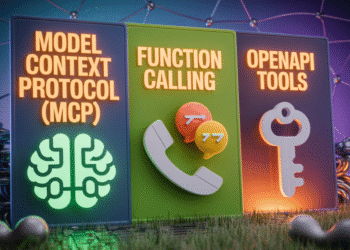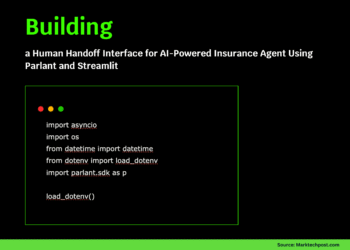
Beyond Vector Search: 5 Next-Gen RAG Retrieval Strategies
Image by Editor | ChatGPT
Introduction
Retrieval augmented generation (RAG) is now a cornerstone for building sophisticated large language model (LLM) applications. By grounding LLMs in external knowledge, RAG mitigates hallucinations and allows models to access proprietary or real-time information. The standard approach typically relies on plain vanilla vector similarity search over text chunks. While effective, this method has its limits, especially when dealing with complex, multi-hop queries that require synthesizing information from multiple sources.
To push the boundaries of what’s possible, a new generation of advanced retrieval strategies is emerging. These methods move beyond simple semantic similarity to incorporate more sophisticated techniques like graph traversal, agent-based reasoning, and self-correction. Let’s explore five of these next-gen retrieval strategies that are redefining the RAG landscape.
1. Graph-Based RAG (GraphRAG)
Traditional RAG can struggle to “connect the dots” between disparate pieces of information scattered across a large document set. GraphRAG addresses this by constructing a hierarchical knowledge graph from source documents using LLMs. Instead of just chunking and embedding, this method extracts key entities, relationships, and claims, organizing them into a structured graph.
Using the Leiden algorithm for hierarchical clustering, GraphRAG creates semantically organized community summaries at various levels of abstraction. This structure enables more holistic understanding and excels at multi-hop reasoning tasks. Retrieval can be performed globally for broad queries, locally for entity-specific questions, or through a hybrid approach.
Differentiator: Builds an LLM-extracted knowledge graph (entities + relations + claims) so retrieval can traverse connections for true multi-hop reasoning instead of isolated chunk similarity.
When to consider: For multi-hop questions like “Trace how Regulation X influenced Company Y’s supply chain from 2018 to 2022 across earnings calls, filings, and news.”
Costs/trade-offs: Upfront LLM-driven entity/relationship extraction and clustering inflate build cost and maintenance overhead, and stale graphs require periodic (costly) refreshes to stay accurate.
2. Agentic RAG
Why stick to a static retrieval pipeline when you can make it dynamic and intelligent? Agentic RAG introduces AI agents that actively orchestrate the retrieval process. These agents can analyze a query and decide when to retrieve, what tools to use (vector search, web search, API calls), and how to formulate the best queries.
This approach transforms the RAG system from a passive pipeline into an active reasoning engine. Agents can perform multi-step reasoning, validate information across different sources, and adapt their strategy based on the complexity of the query. For instance, an agent might first perform a vector search, analyze the results, and, if the information is insufficient, decide to query a structured database or perform a web search for more current data. This allows for iterative refinement and more robust, context-aware responses.
Differentiator: Uses autonomous agents to plan, choose tools (vector DBs, web/APIs, SQL), and iteratively refine retrieval steps, turning a static pipeline into an adaptive reasoning loop.
When to use: For queries that may need tool choice and escalation, such as “Summarize current pricing for Vendor Z and verify with their API if the document set lacks 2025 data.”
Costs/trade-offs: Multi-step planning/tool calls add latency and token spend, and orchestration complexity raises observability and failure-handling burdens.
3. Self-Reflective and Corrective RAG
A key limitation of basic RAG is its inability to assess the quality of the retrieved documents before feeding them to the generator. Self-reflective and corrective strategies, like Self-RAG and Corrective-RAG (CRAG), introduce a self-evaluation loop.
These systems critically assess their own processes. For example, CRAG uses a lightweight evaluator to score the relevance of retrieved documents. Based on the score, it can decide to use the documents, ignore them, or seek additional information, even turning to a web search if the internal knowledge base is lacking. Self-RAG goes a step further by using “reflection tokens” during fine-tuning, teaching the model to critique its own responses and control its retrieval and generation behavior during inference. This self-correction mechanism leads to more accurate and reliable outputs.
Differentiator: Adds a self-evaluation loop that scores retrieved evidence and triggers correction (discard, re-retrieve, or web search), with Self-RAG “reflection tokens” improving reliability at inference.
When to use: For noisy or incomplete corpora where retrieval quality varies, such as “Answer from internal notes, but only if confidence ≥ threshold; otherwise re-retrieve or web-check.”
Costs/trade-offs: Extra scoring, reranking, and fallback searches increase compute and tokens per query, and aggressive filtering can miss edge-case evidence.
4. Hierarchical Tree-Structured Retrieval (RAPTOR)
Chunk-based retrieval can sometimes miss the forest for the trees, losing high-level context by breaking documents into small, independent pieces. The Recursive Abstractive Processing for Tree-Organized Retrieval (RAPTOR) technique builds a hierarchical tree structure over documents to maintain context at multiple levels of abstraction.
RAPTOR works by recursively embedding, clustering, and summarizing text chunks. This creates a tree where leaf nodes contain original text chunks, and parent nodes contain summaries of their children, all the way up to a root node that summarizes the entire document set. At query time, the system can either traverse the tree to find information at the right level of detail or perform a “collapsed tree” search that queries all levels simultaneously. This approach has shown superior performance on complex, multi-step reasoning tasks.
Differentiator: Recursively clusters and summarizes chunks into a multi-level tree so queries can target the right granularity or search all levels at once, preserving global context for complex tasks.
When to use: For long, hierarchical materials: “Locate the root cause section across a 500-page postmortem without losing document-level context.”
Costs/trade-offs: Recursive summarization/clustering expands indexing time and storage, and tree updates on frequent content changes can be slow and expensive.
5. Late Interaction Models and Advanced Dense Retrieval
Dense retrieval models typically condense an entire document and query into single vectors for comparison, which can lose fine-grained details. Late-interaction models like ColBERT offer a powerful alternative by preserving token-level embeddings. It computes embeddings for each token in the query and the document separately. The interaction, or similarity calculation, happens “late” in the process, allowing for a more granular matching of individual terms using a MaxSim operator.
Another advanced technique is HyDE (Hypothetical Document Embeddings). HyDE bridges the semantic gap between a query (often a short question) and potential answers (longer, descriptive passages). It prompts an LLM to generate a hypothetical answer to the user’s query first. This synthetic document is then embedded and used to retrieve real documents from the vector database that are semantically similar, improving the relevance of the retrieved results.
Differentiator: Keeps token-level signals (e.g. ColBERT’s MaxSim) and leverages HyDE’s hypothetical answers to tighten query–document alignment for finer-grained, higher-recall matches.
When to use: For precision-sensitive domains (code, law, biomed) where token-level alignment matters, such as “Find clauses matching this exact indemnification pattern.”
Costs/trade-offs: Late interaction models demand larger, granular indexes and slower query-time scoring, while HyDE adds an LLM generation step per query and extra embeddings, increasing latency and cost.
Wrapping Up
As LLM applications grow in complexity, retrieval strategies must evolve beyond simple vector search. These five approaches — GraphRAG, Agentic RAG, Self-Correction, RAPTOR, and Late Interaction Models — represent the cutting edge of RAG retrieval. By incorporating structured knowledge, intelligent agents, self-evaluation, hierarchical context, and fine-grained matching, they enable RAG systems to tackle more complex queries and deliver more accurate, reliable, and contextually aware responses.
| Technique | Differentiator | When to Use | Costs/Trade-offs |
|---|---|---|---|
| GraphRAG | LLM-built knowledge graph enables global/local traversal for true multi-hop reasoning | Cross-entity/time queries that must connect signals across filings, notes, and news | High graph construction cost and ongoing refresh/maintenance overhead |
| Agentic RAG | Autonomous agents plan steps, pick tools, and iteratively refine retrieval | Queries that may need escalation from vector search to APIs/web/DBs for fresh data | Added latency and token/compute spend; higher orchestration complexity |
| Self-Reflective / Corrective (Self-RAG, CRAG) | Self-evaluation loop scores evidence and triggers re-retrieval or fallbacks | Noisy or incomplete corpora where answer quality varies by document set | Extra scoring/reranking and fallbacks increase tokens/compute; risk of over-filtering |
| RAPTOR (Hierarchical Tree Retrieval) | Recursive summaries form a multi-level tree that preserves global context | Long, structured materials needing the right granularity (section ↔ document) | Costly recursive clustering/summarization; slow/expensive updates on churn |
| Late Interaction & Advanced Dense (ColBERT, HyDE) | Token-level matching (MaxSim) + HyDE’s synthetic queries tighten alignment | Precision-critical domains (code/law/biomed) or pattern-specific clause/code search | Larger granular indexes and slower scoring; HyDE adds per-query LLM + extra embeddings |


















